I climbed Mt. Rainier a couple weekends ago. The summit was a new high point for me, 14,411 ft. It ended up being one of the most fantastic – and difficult – adventures I’ve had. What a beautiful mountain.
It started Thursday evening when my rope team met up to do a gear check and talk about plans, goals, and logistics for the trip. I had borrowed a lot of gear, and it turns out I’ve never been mountaineering before. I hike and rock climb, so I have some basics like a harness and helmet, but glacier travel was totally new to me. A friend lent me an ice axe, glacier glasses, extra carabiners, collapsible shovel, an avalanche beacon (despite low avalache risk for the weekend), cramp-ons, double plastic mountaineering boots, and a balaclava (full head and face mask) in case of extreme cold at the top. I ended up using everything except the beacon and balaclava. This trip was wild.
We confirmed that everyone was fully equipped, had a couple big bowls of pasta, and enjoyed a beer over discussion. It was really good to talk about goals for the trip, summer camp style. Mine started out as pretty much just wanting to reach the summit, but I started to realize there was going to also be a huge opportunity for learning and practice over the weekend, and I started getting more excited about that. The phrase “mental elevation” came up, which I thought was cool but wouldn’t really understand until about 60 hours later.
Satisfied with our discussion and bags packed up, we set our alarms for 4:45 am and got in sleeping bags to catch as much sleep in the remaining 5 hours as possible.
And 4:45 came quickly, as it always has in my experience. We secured our packs, loaded up the car, and took off for the mountain, about 2 hours southeast of Seattle. We had reserved campsites ahead of time, but still ended up getting caught in a line at the ranger station for about 45 minutes. You don’t expect a line at 6:30 am, but that is how the mountain works. We filled out our trip plan and set out. We ended up with a campsite at Glacier Basin for Friday night (about 3.5 miles in at 5,000 ft), Camp Schurman for Saturday night (another ~3.5 miles at 9,500 ft), and another night at Schurman on Sunday if necessary. We wouldn’t be doing the rush up and down the mountain that some people do, so there would be time to practice glacier skills and get a bit used to the altitude. Pretty much ideal.
So we strapped on our packs and got moving. I think we were all hauling about 40-50 lbs, but even so, 3.5 miles goes quickly. The trail was nicely maintained and mostly snow free. They had had a serious wash out a few years back, and the trail has been completely rebuilt. All in all, an easy walk. We got to our first campsite around 11 am, leaving plenty of time to practice knots and self arrests. We set up camp and took a breather. The 4:45 am wake was pretty apparent, and our conversational skills were in a serious decline. I looked over a mountaineering book and dozed off on a sunny rock.
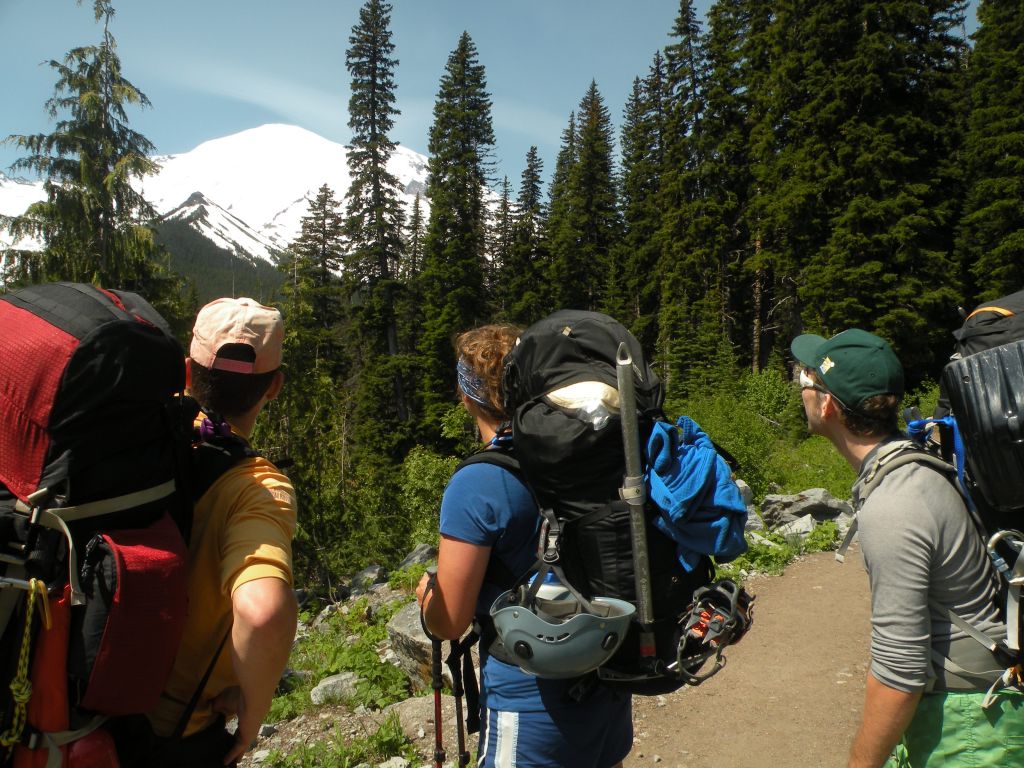
Evan, Greta, and Justin scoping out what lies ahead
After a bit of back and forth between half-wakeful studying and half-restful dozing, we all got back together for the hands-on practice. We roped up, did some laps around the snowfield, practicing commands and arrests. Informative and necessary, but definitely clouded by lingering exhaustion. Around 5 or 6 we decided to cook some dinner and get tidied up for sleep. The plan was to hit the trial while the snow/ice was still good (i.e., not slushy yet), so we set our clocks for a 4 am wake up. We were in our bags by 10 pm, and these 6 hours would be the longest rest of the trip.
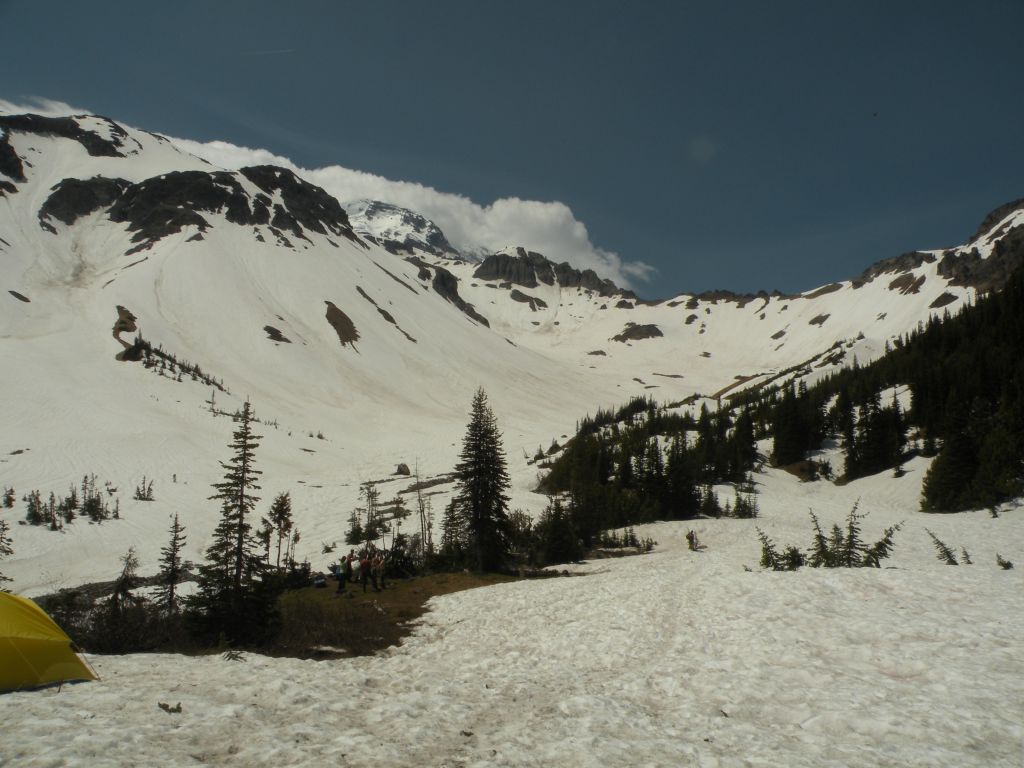
Snowfield at Glacier Basin
And this time I was a little bit more ready for 4 am when the alarms started chiming. It is a good feeling to be up before the sun. The moon and stars were beautiful. We had a quick breakfast and chai tea and packed up camp. By the time we got moving, the sun was starting to shine on the western edge of the basin. It felt good to be moving in the shade – things would clearly be getting hot when the sun surfaced fully. We worked our way slowly up Inter Glacier on the way to camp Schurman. There weren’t any crevasses on this one, but it did get pretty steep toward the end. Our early start paid off, and we were rewarded with some pretty spectacular views by about 9 am. At the top of the ridge we roped up to move onto Emmons Glacier. We were expecting minor crevasses, but mostly we wanted to get some experience on the rope and with our knots. We snacked and hiked, practiced setting some gear, snacked and hiked some more. We might have taken our time a little too liberally and ended up at camp around 1 pm. We were greeted by David Gottlieb, a reknowned mountaineer who has climbed Rainier enough times to be “too embarassed to keep track” anymore. He gave us some tips on our knots and packing and wished us luck. We were reassured to find out that he would be summitting Sunday morning about the same time as us.
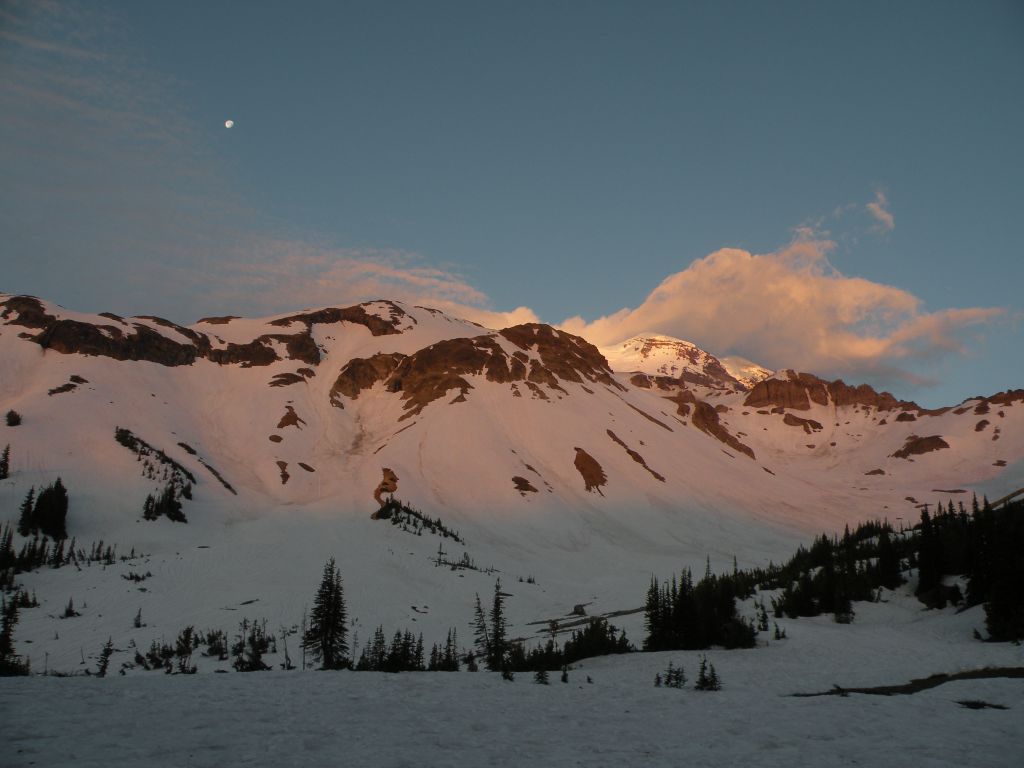
Sunrise on the mountain
1 pm may not seem like a late arrival into camp, but we were already moving pretty slowly. At 10,000 ft everything takes longer than you expect. We set up the tents, got a water-drip going to fill our bottles, played a game of Euchre, and suddenly it was 5 pm – later than we had hoped for dinner. We cooked, ate ravenously, and cleaned. Suddenly 8:30 pm. We decided on a very early start – 12:30 am. So we set our alarms for 11:30 pm and got in our bags for a glorious 2.5 hours of rest.
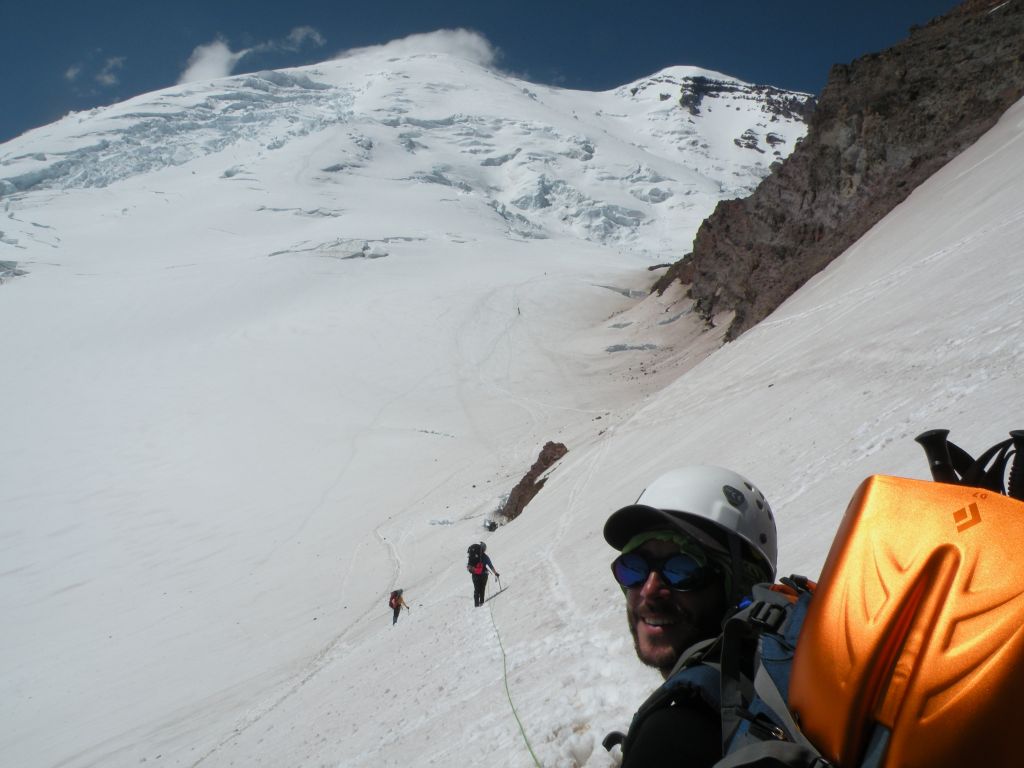
All geared up, heading for Camp Schurman
I actually didn’t realize that we had planned on so little rest (or I didn’t know what time it was when we went to sleep), and I felt surprisingly good when the clocks went off. Adrenaline and excitement for the summit certainly had something to do with it. It was beautiful out. The snow and ice were nice and solid, the sky was clear and full of stars. The moon was just rising and the whiteness of the mountain made the landscape feel extraterrestrial. Again, altitude and lack of sleep contributed. Either way, really amazing. We roped up and got in line. There were already other teams leaving, and we ended up being about the 7th team to set off. More would be coming up behind us, and it would clearly be a busy day on the mountain.
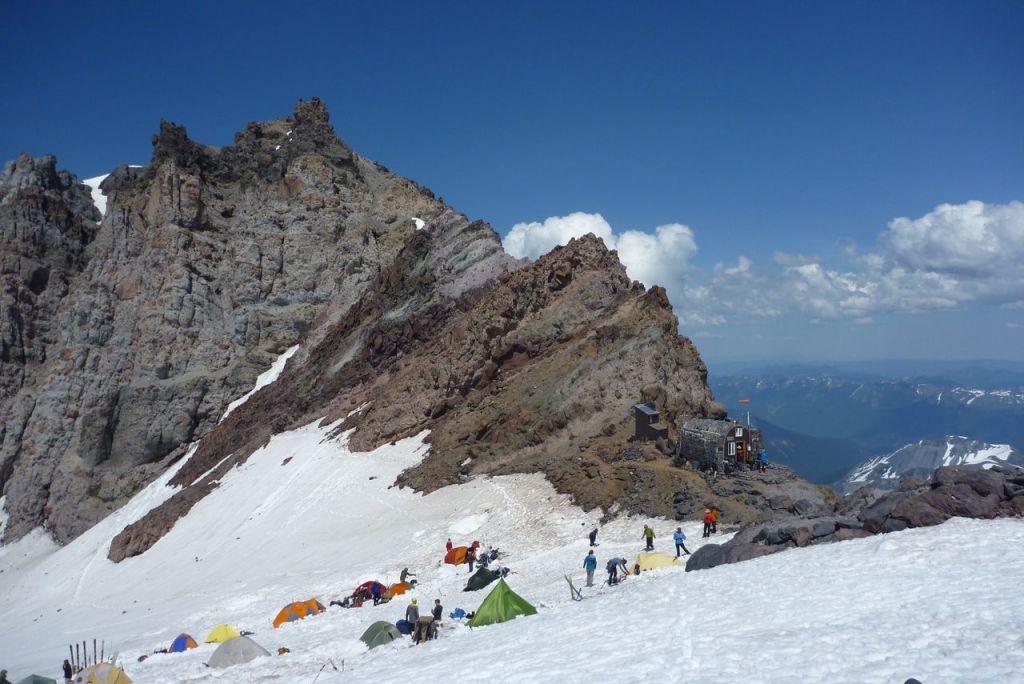
Arrived at Camp Schurman – Photo courtesy of Evan
Things got steep right off the bat, but we were in a pretty good zone. Circles of light from headlamps were moving up the glacier ahead of us and behind and it was easy to fall into a rhythm. After trekking a good way up the first section we stopped for snacks and realized it was already 2:45 am. There was one tricky section involving a snow bridge that had lost some of its integrity the day before, but it was still cold enough that there were no issues moving across it. We pressed on and it was 4:30. The sun was starting to rise directly opposite the glacier, giving us a wonderful light show. It got bright and things warmed up a bit, with the wind picking up as well to counteract the heat.
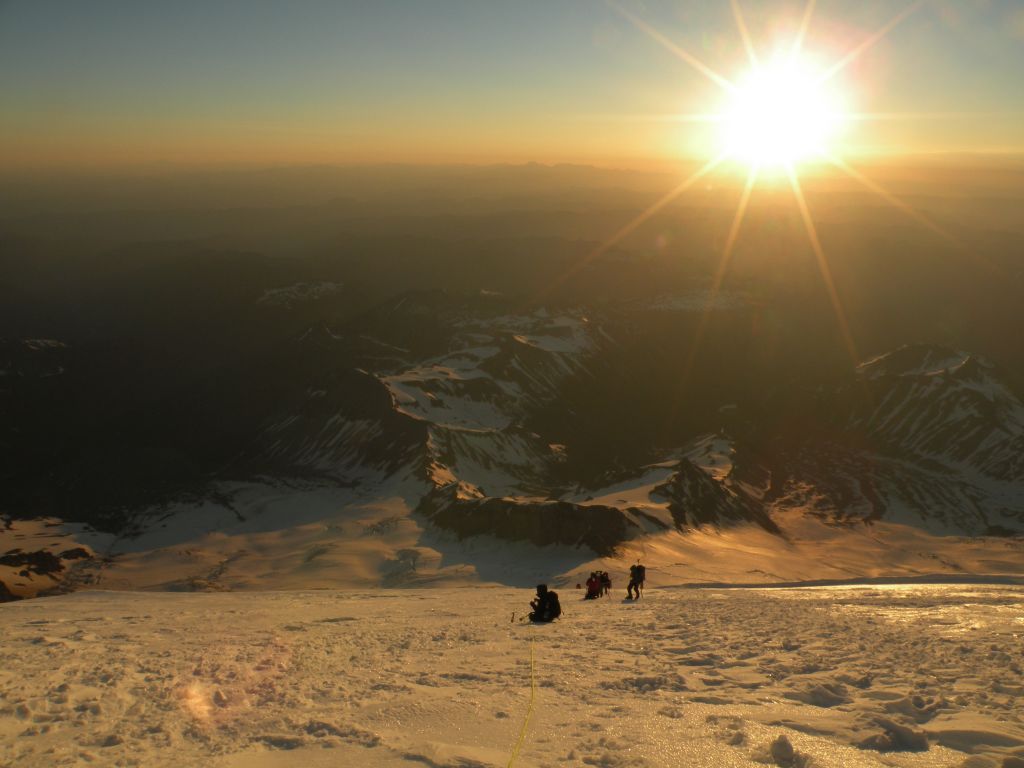
Sunrise over Washington
This continued for some time. We had some trouble with the pace and congestion at this point – we kept having to stop behind slow groups, but couldn’t get enough momentum to pass them and stay ahead. So we alternated between getting cold and getting tired, not ideal. Around 7:30 am we stopped for a longer break, about 15 minutes. We were about 700 ft from the summit, but we were getting worn down. The altitude was kicking in and it was hard to stay focused. We chatted about our energy level and motivation, and decided that if we weren’t on the summit by 10 am we would turn around and head back. Pretty generous, but it seemed like a good goal at the time. We had another snack and got our legs moving again.
The slightly longer rest and chat had motivated us, and we ended up being pretty solid the rest of the way to the summit. We slowly realized we had arrived as we saw rock and climbers resting. 8:30 am. There were some wispy clouds around and the wind was whipping across the crater. Not a very hospitable place. We could see north to Baker, but a light haze kept the views from extending more than a couple hundred miles. It felt really good to be at the top, and a huge relief to know that we wouldn’t have to go up any further.

Team Kraken at the top – Photo courtesy of Greta
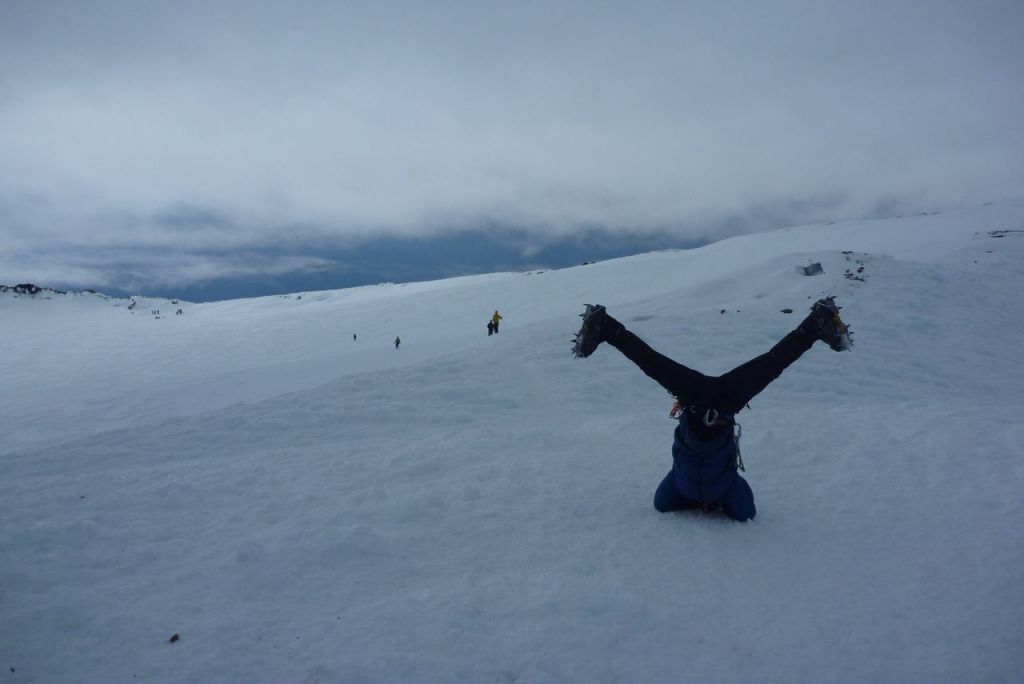
I am upsidedown – Photo courtesy of Greta
The wind was keeping us from enjoying the rest too much though. We were feeling the cold and decided it would be best to make our stay short. We snapped a few photos, tightened up our gear and set off for the descent. We kept our cramp-ons on in case we came to any icy patches, but things were getting pretty slushy and we probably could have moved a bit faster without them. Still, the descent was a relief and it felt like we were covering ground in no time. We stopped briefly a couple more times to snack and plodded on. We found that the snow bridge we had crossed earlier had melted out a bit more, requiring a short jump to get across. We played is safe and set some protection in the snow in case of a slip and made it across without trouble.
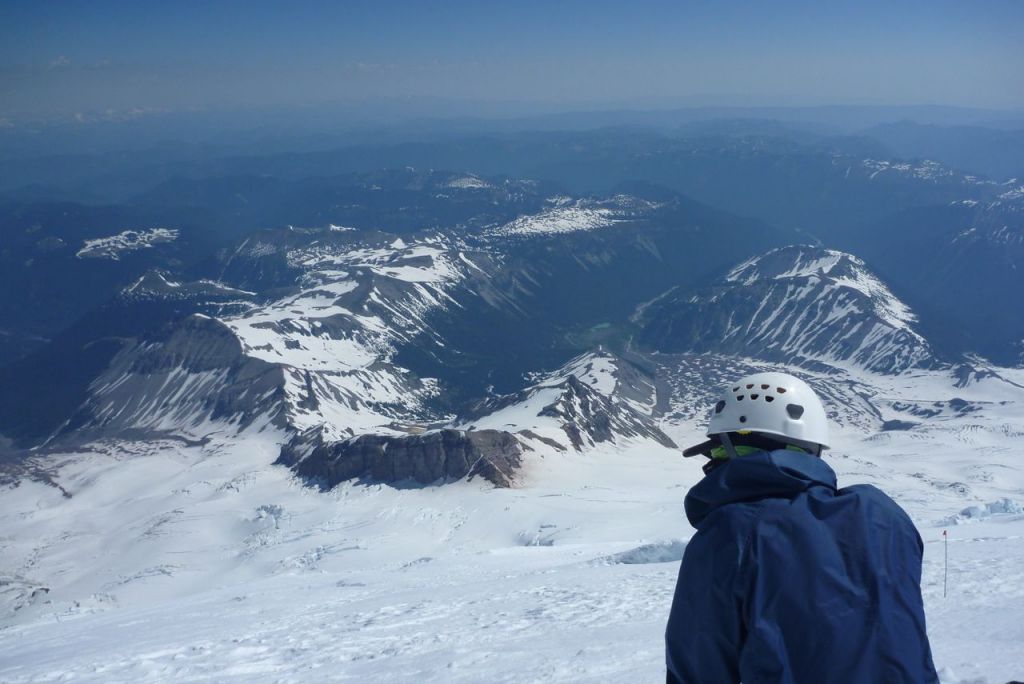
It is a long way down – Photo courtesy of Greta

A short leap over a crevasse
After some final knee-high-slush trudging, we made it back to Camp Schurman where are tents were waiting for us, 1 pm. We shed our packs and crawled into sleeping bags for a quick rest. We could stay another night there if we wanted, but we had heard that there were thunder storms were on the way. We slept about an hour and a half and packed up camp. We loaded up our bags by 5 pm and got on the rope for one last stretch of glacier travel. We were exhausted but happy, and everything went smoothly. We got to Inter Glacier, the steep snowfield from the second day, and were greeted by a nicely groomed glissade track. Strapping our gear on tightly, we sat on our butts and got ready to slide. It felt terrific. The 3-mile snowfield which had taken us 3-4 hours to climb a day early quickly receeded in about 15 minutes of amusement park-style enjoyment. The snow cooled our legs, pretty much bliss. Within the hour we were back to our first camp and on our way out on a 3.5 mile dirt trail. Our heads were clear with the reduced altitude, but foggy from exhaustion. The hike felt more like about 7 miles, but we made it. We got to the car at 9 pm and took our boots off to great relief. Success! We had reached the summit and made it back down in one piece. It felt incredible. And it was really hard. We were totally beat, loopy, hungry for something other than Power Bars.

Glisssssaaaade!
We got in the car hoping to find burgers, but Enumclaw is a sleepy town at 10 pm on a Sunday, so we settled for the 24-hour Safeway. Another meal of snacks, but at this point it didn’t really matter. We got back to Seattle around midnight, ready for some hot showers and warm beds. In bed by 1 am, up at 8 am for work. 7 hours felt luxurious. What a weekend.

Made it back!

What It’s Like to Play in a Band
/0 Comments/in Adventures, Music, Seattle /by mdcalabroEight months ago I joined a band in Seattle, Pocket Panda. I’ve played music most of my life and in all sorts of groups, but this was my first experience in a “rock band”. It has been a blast and has exposed me to a new and exciting scene in Seattle.
BACKGROUND
In terms of musical background, I’m very much classically trained. I’ve played cello since I was about eight, took a couple years of piano lessons, and picked up trombone in middle and high school for concert and jazz bands. In high school, I also started fooling around with guitar, mostly struggling to play Pink Floyd and Dave Matthews covers. I got a lot more serious about guitar a few years ago when I got into country blues. I never practiced my voice, but I’ve been getting more involved with that lately. When I went traveling abroad, I brought a ukulele and fell for that as well. I’ve played in orchestras, string ensembles, musicals, and as my focus shifted to guitar, by myself or with a friend. But never in a band, never in a self-directed group with the purpose of creating original music to perform regularly.
One night after practicing some Bach Cello Suites, I put on a Shostakovich trio I hadn’t listen to for a while. At the time, I was playing in a casual string quartet, mostly Mozart-era repertoire. The Shostakovich reminded me of some of the fantastic small-ensemble pieces I had played in high school (when I was the most serious about cello), and I decided to scan Craigslist for a couple folks who might be interested in a serious endeavor like that. The result: no string ensembles. A couple people offering cello lessons. An amateur orchestra with open auditions. And one “indie-rock band with folk tendencies” looking to augment their string section.
I listened to the only song they had posted on their website, and I liked the sound a lot. I was feeling reckless with the boundaries of my comfort zone, so I decided to send an email. I met up with the lead singer, went to a couple trial practices, and learned a couple of their songs. Within about a month I was part of the band.
And it has been a blast. The newness of the experience has been terrific; my comfort zone has undoubtedly expanded. I’m constantly learning about how the music scene in Seattle works and what it takes to put this kind of group together. I’ve gotten comfortable with playing shows – at least as the cellist. The idea of singing still freaks me out, but I’m getting more comfortable with it. And the cliche about a band being like a relationship – well, it’s completely true.
PRACTICE
Here’s how it works. We rent a practice space in a grungy part of town for a couple hundred bucks a month. It usually suits our needs perfectly – enough room for the seven of us – but it can get noisy when other bands choose the same practice times as us. We practice twice a week for a few hours each time, and we occasionally have smaller meet-ups to work on specific parts and harmonies. The lead singer writes the lyrics and structure for most of our songs and we use our practice time to hash out the direction and details of the rest of the parts. At the moment we’ve got about a full record’s worth of original music, all of which we’ve performed, but most of which we haven’t had the time or funds to record.
SHOWS
Playing shows has been the biggest step out of my comfort zone, and also the most rewarding. I remember feeling some nervousness performing when I was younger, especially when my part was exposed or when I didn’t feel totally solid with the music. I haven’t felt even a hint of nerves thus far playing with the band. Partly this is due to the circumstance – I am sitting, which decreases my exposure, and my parts are not all that technically difficult. I am also confident with the cello. It is second nature to be playing it in front of people. Vocals are a different story. Even just thinking about singing into a microphone makes my palms clammy. I also can’t play cello and sing at the same time yet. Both things I’m actively working on.
And so shows are a joy to play. Every one has been fun, even when the audience is small or distracted. There is a feeling of energy on stage happening in the space between us, a spark that doesn’t happen during practice. We know our songs well, and this is our opportunity to send our energy and emotion out into the crowd. When we play at bars we usually get a couple free drink tickets a piece, which is sometimes the biggest part of our payment. At slightly larger venues, we usually split the cover with the other bands playing and the bar, and can take home a couple hundreds bucks or more on a decent night. Not enough to make any money, but enough to help with practice space rent and recording. A few of our shows have had great backstage setups – couches, coolers of beer, free food. It’s fun to feel like a VIP for the night.
Another piece that has made these shows so enjoyable is the immense support I’ve gotten from my friends in town. I’m lucky to be part of such a good group of people. They come out to shows and do fun things like cheer my name between songs (“Why is everyone cheering for to cellist??”). It makes the events feel intimate and comfortable. A real joy.
THE GROUP
Because we spend so much time together as a group, and because we’re exploring something that each of us feels passionately about, being in the band can feel like being in a relationship. A few months ago our drummer got upset with the rest of us and quit the band (he has been replaced, and our new drummer is stellar). This experience was the most similar to breaking up with a romantic partner that I’ve had. Harsh words were shared. We had to coordinate his moving his stuff out of our space. A lot of eye contact was avoided. Emotionally wrought emails were exchanged throughout the process. Luckily there were still six of us to keep the relationship going. We were able to move on, and we found someone great to take his place. And for now, we all get along well. We still have differences of opinion, but for the most part we’re able to communicate about them and find some middle ground. Good communication – a universal necessity for successful relationships.
I’m excited now to see how we grow as a band. We recently got together with a manager. We’ll be putting together a KickStarter or IndieGoGo campaign soon so we can (if it succeeds!) afford to record a full-length album. We’re pushing for bigger shows and more radio play. Things are moving in fun directions, and people seem to like what we’re making. I’ll keep you posted!
Have questions about what it’s like to be in a band? Post a comment and I’ll try to address it next time I write about it. To listen to Pocket Panda, check out our Bandcamp page. If you like what we’re doing, you can stay updated on Facebook and Twitter. Enjoy!
Taking the Plunge
/6 Comments/in Adventures, Art, Awareness, Existence, Mind, Music /by mdcalabroLast week I gave notice at my job. It was a good job in an industry I had been excited about. It paid well and had all sorts of perks like subsidized bus pass, health insurance, and unlimited free coffee and Advil. Something wasn’t working for me, though, and after a good deal of confusion and mental processing, I decided to leave. I have a plan.
I have come to similar moments in my life before. I usually feel a need to explore and expand after I finish a big thing – college, grad school, internships. These moments are wonderful. I find new passions, meet new people, stretch my comfort zone, and learn a little bit (or a lot) about life and myself. I tend to wander a bit and eventually find a mold of a life that I want to lead next.
This time is a little bit different, though. For the first time, I am initiating the transition from within. I am not finishing a conveniently timed graduate program, but rather taking a plunge and creating a life shaped around my own values and passions. I want to build the mold myself, and make it out of something that is pliable over time. I’m taking a big step into the unknown, and I’m excited about every part of it.
Here is what I want to do. I want to live a life where I have control and freedom. I want to create things that are valuable to me, and I want to learn how to deliver those things to other people who value them as well. Maybe at some point there will be money exchanged; that will be part of the learning process. I want to explore and share my experiences. I want to live fully and courageously. And I think that I am creative enough and smart enough and disciplined enough to make it work. Or maybe just stupid enough to try.
I am going to start with art and music and writing. I have dabbled in these creative pursuits my whole life, but I have never dedicated myself to them completely. I’m pretty sure that dedication is the only way to actually make them work. I’ve got some money saved up from working at desks and on construction sites, and I have about as much spatial and temporal flexibility as I’m ever likely to have again. So now is the time. I’ve always been curious about delving into these creative endeavors, and I feel like I won’t be satisfied until I’ve tried and know that it works or doesn’t work or isn’t for me. Or that it is a hard way to make a life, but is nonetheless exactly what I want to be doing.
I’ll let you know how it goes. Suggestions welcome.
Summiting Mt. Rainier
/5 Comments/in Adventures, Awareness, Body, Climbing, Hiking, Photos, Snow, Washington /by mdcalabroI climbed Mt. Rainier a couple weekends ago. The summit was a new high point for me, 14,411 ft. It ended up being one of the most fantastic – and difficult – adventures I’ve had. What a beautiful mountain.
It started Thursday evening when my rope team met up to do a gear check and talk about plans, goals, and logistics for the trip. I had borrowed a lot of gear, and it turns out I’ve never been mountaineering before. I hike and rock climb, so I have some basics like a harness and helmet, but glacier travel was totally new to me. A friend lent me an ice axe, glacier glasses, extra carabiners, collapsible shovel, an avalanche beacon (despite low avalache risk for the weekend), cramp-ons, double plastic mountaineering boots, and a balaclava (full head and face mask) in case of extreme cold at the top. I ended up using everything except the beacon and balaclava. This trip was wild.
We confirmed that everyone was fully equipped, had a couple big bowls of pasta, and enjoyed a beer over discussion. It was really good to talk about goals for the trip, summer camp style. Mine started out as pretty much just wanting to reach the summit, but I started to realize there was going to also be a huge opportunity for learning and practice over the weekend, and I started getting more excited about that. The phrase “mental elevation” came up, which I thought was cool but wouldn’t really understand until about 60 hours later.
Satisfied with our discussion and bags packed up, we set our alarms for 4:45 am and got in sleeping bags to catch as much sleep in the remaining 5 hours as possible.
And 4:45 came quickly, as it always has in my experience. We secured our packs, loaded up the car, and took off for the mountain, about 2 hours southeast of Seattle. We had reserved campsites ahead of time, but still ended up getting caught in a line at the ranger station for about 45 minutes. You don’t expect a line at 6:30 am, but that is how the mountain works. We filled out our trip plan and set out. We ended up with a campsite at Glacier Basin for Friday night (about 3.5 miles in at 5,000 ft), Camp Schurman for Saturday night (another ~3.5 miles at 9,500 ft), and another night at Schurman on Sunday if necessary. We wouldn’t be doing the rush up and down the mountain that some people do, so there would be time to practice glacier skills and get a bit used to the altitude. Pretty much ideal.
So we strapped on our packs and got moving. I think we were all hauling about 40-50 lbs, but even so, 3.5 miles goes quickly. The trail was nicely maintained and mostly snow free. They had had a serious wash out a few years back, and the trail has been completely rebuilt. All in all, an easy walk. We got to our first campsite around 11 am, leaving plenty of time to practice knots and self arrests. We set up camp and took a breather. The 4:45 am wake was pretty apparent, and our conversational skills were in a serious decline. I looked over a mountaineering book and dozed off on a sunny rock.
Evan, Greta, and Justin scoping out what lies ahead
After a bit of back and forth between half-wakeful studying and half-restful dozing, we all got back together for the hands-on practice. We roped up, did some laps around the snowfield, practicing commands and arrests. Informative and necessary, but definitely clouded by lingering exhaustion. Around 5 or 6 we decided to cook some dinner and get tidied up for sleep. The plan was to hit the trial while the snow/ice was still good (i.e., not slushy yet), so we set our clocks for a 4 am wake up. We were in our bags by 10 pm, and these 6 hours would be the longest rest of the trip.
Snowfield at Glacier Basin
And this time I was a little bit more ready for 4 am when the alarms started chiming. It is a good feeling to be up before the sun. The moon and stars were beautiful. We had a quick breakfast and chai tea and packed up camp. By the time we got moving, the sun was starting to shine on the western edge of the basin. It felt good to be moving in the shade – things would clearly be getting hot when the sun surfaced fully. We worked our way slowly up Inter Glacier on the way to camp Schurman. There weren’t any crevasses on this one, but it did get pretty steep toward the end. Our early start paid off, and we were rewarded with some pretty spectacular views by about 9 am. At the top of the ridge we roped up to move onto Emmons Glacier. We were expecting minor crevasses, but mostly we wanted to get some experience on the rope and with our knots. We snacked and hiked, practiced setting some gear, snacked and hiked some more. We might have taken our time a little too liberally and ended up at camp around 1 pm. We were greeted by David Gottlieb, a reknowned mountaineer who has climbed Rainier enough times to be “too embarassed to keep track” anymore. He gave us some tips on our knots and packing and wished us luck. We were reassured to find out that he would be summitting Sunday morning about the same time as us.
Sunrise on the mountain
1 pm may not seem like a late arrival into camp, but we were already moving pretty slowly. At 10,000 ft everything takes longer than you expect. We set up the tents, got a water-drip going to fill our bottles, played a game of Euchre, and suddenly it was 5 pm – later than we had hoped for dinner. We cooked, ate ravenously, and cleaned. Suddenly 8:30 pm. We decided on a very early start – 12:30 am. So we set our alarms for 11:30 pm and got in our bags for a glorious 2.5 hours of rest.
All geared up, heading for Camp Schurman
I actually didn’t realize that we had planned on so little rest (or I didn’t know what time it was when we went to sleep), and I felt surprisingly good when the clocks went off. Adrenaline and excitement for the summit certainly had something to do with it. It was beautiful out. The snow and ice were nice and solid, the sky was clear and full of stars. The moon was just rising and the whiteness of the mountain made the landscape feel extraterrestrial. Again, altitude and lack of sleep contributed. Either way, really amazing. We roped up and got in line. There were already other teams leaving, and we ended up being about the 7th team to set off. More would be coming up behind us, and it would clearly be a busy day on the mountain.
Arrived at Camp Schurman – Photo courtesy of Evan
Things got steep right off the bat, but we were in a pretty good zone. Circles of light from headlamps were moving up the glacier ahead of us and behind and it was easy to fall into a rhythm. After trekking a good way up the first section we stopped for snacks and realized it was already 2:45 am. There was one tricky section involving a snow bridge that had lost some of its integrity the day before, but it was still cold enough that there were no issues moving across it. We pressed on and it was 4:30. The sun was starting to rise directly opposite the glacier, giving us a wonderful light show. It got bright and things warmed up a bit, with the wind picking up as well to counteract the heat.
Sunrise over Washington
This continued for some time. We had some trouble with the pace and congestion at this point – we kept having to stop behind slow groups, but couldn’t get enough momentum to pass them and stay ahead. So we alternated between getting cold and getting tired, not ideal. Around 7:30 am we stopped for a longer break, about 15 minutes. We were about 700 ft from the summit, but we were getting worn down. The altitude was kicking in and it was hard to stay focused. We chatted about our energy level and motivation, and decided that if we weren’t on the summit by 10 am we would turn around and head back. Pretty generous, but it seemed like a good goal at the time. We had another snack and got our legs moving again.
The slightly longer rest and chat had motivated us, and we ended up being pretty solid the rest of the way to the summit. We slowly realized we had arrived as we saw rock and climbers resting. 8:30 am. There were some wispy clouds around and the wind was whipping across the crater. Not a very hospitable place. We could see north to Baker, but a light haze kept the views from extending more than a couple hundred miles. It felt really good to be at the top, and a huge relief to know that we wouldn’t have to go up any further.
Team Kraken at the top – Photo courtesy of Greta
I am upsidedown – Photo courtesy of Greta
The wind was keeping us from enjoying the rest too much though. We were feeling the cold and decided it would be best to make our stay short. We snapped a few photos, tightened up our gear and set off for the descent. We kept our cramp-ons on in case we came to any icy patches, but things were getting pretty slushy and we probably could have moved a bit faster without them. Still, the descent was a relief and it felt like we were covering ground in no time. We stopped briefly a couple more times to snack and plodded on. We found that the snow bridge we had crossed earlier had melted out a bit more, requiring a short jump to get across. We played is safe and set some protection in the snow in case of a slip and made it across without trouble.
It is a long way down – Photo courtesy of Greta
A short leap over a crevasse
After some final knee-high-slush trudging, we made it back to Camp Schurman where are tents were waiting for us, 1 pm. We shed our packs and crawled into sleeping bags for a quick rest. We could stay another night there if we wanted, but we had heard that there were thunder storms were on the way. We slept about an hour and a half and packed up camp. We loaded up our bags by 5 pm and got on the rope for one last stretch of glacier travel. We were exhausted but happy, and everything went smoothly. We got to Inter Glacier, the steep snowfield from the second day, and were greeted by a nicely groomed glissade track. Strapping our gear on tightly, we sat on our butts and got ready to slide. It felt terrific. The 3-mile snowfield which had taken us 3-4 hours to climb a day early quickly receeded in about 15 minutes of amusement park-style enjoyment. The snow cooled our legs, pretty much bliss. Within the hour we were back to our first camp and on our way out on a 3.5 mile dirt trail. Our heads were clear with the reduced altitude, but foggy from exhaustion. The hike felt more like about 7 miles, but we made it. We got to the car at 9 pm and took our boots off to great relief. Success! We had reached the summit and made it back down in one piece. It felt incredible. And it was really hard. We were totally beat, loopy, hungry for something other than Power Bars.
Glisssssaaaade!
We got in the car hoping to find burgers, but Enumclaw is a sleepy town at 10 pm on a Sunday, so we settled for the 24-hour Safeway. Another meal of snacks, but at this point it didn’t really matter. We got back to Seattle around midnight, ready for some hot showers and warm beds. In bed by 1 am, up at 8 am for work. 7 hours felt luxurious. What a weekend.
Made it back!
The Plan: Record an Album
/3 Comments/in Adventures, Music /by mdcalabroI’ve been thinking about goals and productivity a lot lately, and I decided I need a firm commitment. So I am writing and recording an album for release by the end of the year.
I’m setting this firm, measurable goal for myself, and I’m making it public to improve my chances of success. I figure, the more people to hold me to it the better. I will also be writing about the process, which should be fun and possibly informative.
The album will mostly be guitar and vocals, but it will probably also have bits of cello, ukulele, and piano. I’ve maybe written one and a half songs for it at this point, but I’m not sure how much of that will end up on the final version. It will take a good amount of discipline to get these all written and to a level of quality that I’m happy with.
I joined a band about six months ago, and that has given me a glimpse into the music world and confidence that this is something I can accomplish on my own. We’ve been recording a bit and playing shows around town. We’ve even gotten some radio play, which is awesome. I love the momentum that’s building and want to do more of it. Hence the Plan.
Expect to hear more about this, and feel free to give me a hard time if I don’t seem to be making it happen. In fact, please do.
Greene: The Elegant Universe
/1 Comment/in Awareness, Books, Existence, Science /by mdcalabroBrian Greene’s popular work on string theory, The Elegant Universe, lays out the potential “theory of everything” in understandable prose, and describes the evolution of physics that led up to its formulation.
When I call the prose understandable, I mean that in a relative sense. It’s not a Hunger Games-type read, but if you’re not frightened away by the idea of curved space-time, supersymmetry, and 6 (or 7) tightly wrapped invisible dimensions, you’ll be fine. I majored in physics in college, so I approached The Elegant Universe with a decent base level of understanding, but I’d certainly never delved into string theory before. I had always just kind of imagined it as it sounds: a universe composed of very small vibrating strings. And it turns out, that’s pretty much what it is. With lots of nuances and implications and difficult math. Greene does a terrific job of bringing out the core of the theory in a comprehensible and natural way, and ultimately gives a compelling case for the theory being a big step toward the elusive “Theory of Everything.”
The first half of the book describes the theories preceding string theory, namely general relativity and quantum mechanics. Greene makes the transition from Newtonian physics to general relativity seem almost intuitive. The math is the really hard part, but it is fun to imagine what it means for space to be warped and curved in a gravitational field (not just the objects, but the actual extent of space). And it is fun to try to imagine the most immense objects in the universe – and then to conceive of distances so great that those objects appear vanishingly small. I’ve always found this line of thinking much more natural and exciting than going the direction, that is, zooming in so far that quantum mechanics comes into play.
Quantum mechanics was one of the top reasons I stopped doing physics after college, which I would guess is not an uncommon reaction. It is physically counter-intuitive, but the part that got me is that it is really only accessible through the math. Despite all of its obscurity, quantum mechanics is the most precisely measured theory out there. Nobody really knows why it works, but it works better than anything else we’ve ever come up with. Kind of infuriating. And I think that my preference for general relativity over quantum mechanics also tells something about how my mind works. I definitely prefer losing myself in big, expansive (right brain?) thoughts rather than the precise mechanical details (left brain?).
The second half of the book focuses on string theory itself – its conception, evolution, and current (as of a decade ago) highlights and issues. The idea behind string theory (or M-theory, which is thought to encompass string theory) is very elegant indeed. Rather than the universe being made up of point particles (i.e electrons, quarks, muons, neutrinos, etc) that have literally zero spatial extent, string theory claims these particles are actually tiny vibrational waves, little closed loops, dancing around the cosmos. Strings that vibrate more have higher energy, and thus higher mass. They can interact with each other in all sorts of ways, which we call the gravitational, electromagnetic, strong, and weak forces. The fact that the particles have non-zero spatial extent helps resolve the fundamental incompatibilities between general relativity and quantum mechanics while preserving the core of each.
The difficulty again is the math. It’s really hard to do these calculations, and in fact even figuring out the exact equations that need to be solved is still beyond us. Oh, it also gives rise to 6 (in string theory itself, 7 in the broader M-theory) tightly curled up, invisible dimensions beyond the 4 extended space-time dimensions we are familiar with.
The most enjoyable part of the book for me was revisiting a topic I used to be very familiar with that I have left to collect dust in the back of my mind. It reminded me of my initial excitement about physics, for seeking an elegant solution to a physical problem and for connecting laws in such a way that physical reality makes a little bit more sense. The text itself made me want to get back into physics and try my hand at some of the more fundamental questions out there.
The end notes, however, quickly quashed this desire. They are exactly the reason I did not stay in physics. All the low-hanging fruit has been picked, and what’s left is only accessible through obscure mathematics, non-Euclidean geometry, and perturbation theory. It is a field where months and years of intense focus on calculations can yield no useful results. This sounds painful to me. Again, I’d much rather have my head in the clouds than in the weeds. I suspect my relationship with physics will stay at the “general overview” stage from here on out, enjoying books like The Elegant Universe or A Brief History of Time, while watching TED talks to see what’s on the cutting edge of the field.